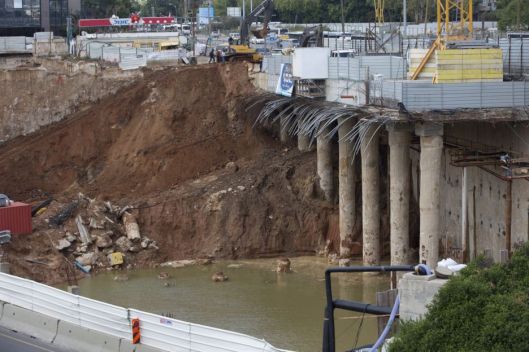Tel Aviv, the financial center of Israel, is notoriously known for its housing shortage and rapidly rising prices (some of it due to the incompetent Israel planning regime). On more than one occasion it seems as if the regulations have been put in place to insure chronic housing shortage. Building anything next to something else is almost impossible, while creating new cheap apartments in centrally located areas belongs to the realm of science fiction.
Last week gave us just such as an example in a project called the Young Towers (although nobody living today will be young when they are completed). This project consists of two towers of over 40 floors each (video visualization here), under construction right next to the corner of Arlozorov Street and Begin Road (named after the late Israel PM Menachem Begin and not related to any actual beginnings). Although the project is located in the commercial center of the metro area next to the largest train station in Israel and with plenty of public transit access, the authorities made the developer build six underground floors (!) for car housing parking. Digging that deep the developers had not reached molten lava, but did hit the groundwater sucking money and time out of the project. Even a special Dutch expert brought in to address the issue (and who knows better than the Dutch how to keep the sea dry) could not handle the situation. This is a photo taken from this article (in Hebrew) describing the boondoggle that the project got drowned in:
Groundwater stops construction of an extensive underground parking lot. (source)

This shows Israeli planning at its current worst and resembles many situations in places that are not as backward as Tel Aviv. The main priority of planning committees in Israel lies in providing cheap accommodation for cars, while every other objective (housing, schools and so forth) gets pushed back. Israel has planning regulations that dictate the provision of at least one off-street parking spot for each new residential unit, while completely ignoring the size of the new unit and its location. On top of this policy directive, municipalities tend to provide free on-street parking at all times, leading many underground lots to be underused as people keep searching for free spots above ground.
Alan Durning from the Sightline Institute composed an eye-opening post on such mandatory parking lots in Seattle, which he termed “Apartment Blockers” due to the cost and time they add to the construction of new housing units, and the fact that these requirements lead to reductions in the amount of housing units a developer is allowed to build:
City requirements for off-street parking spaces jack up rents. They jack it up a lot at the bottom of the housing ladder. Proportionally speaking, the bigger the quota and the smaller the apartment, the larger the rent hike. For one-bedroom apartments with two parking places, as is required in places including Bothell and Federal Way, Washington, as much as one-third of the rent may actually pay for parking. A flotilla of studies supports that claim, and I’ll summarize them in this article, but first, a case study of residential real estate development may illuminate how critical parking is to the affordability of housing.
While Tel Aviv may be a little bit behind regarding rational urban development it’s surprising that even urban role models such as Portland, Oregon have the same stupid rules. We can take some comfort in the fact that more people are aware that “free” parking is anything but free, and that parking is, in fact, not a public good. Even the city of Mumbai has finally started to charge a fee for on-street parking.
Tel Aviv should learn the obvious lesson from this groundwater case and start focusing its planning priorities on those among us who really need central and affordable housing – humans.
